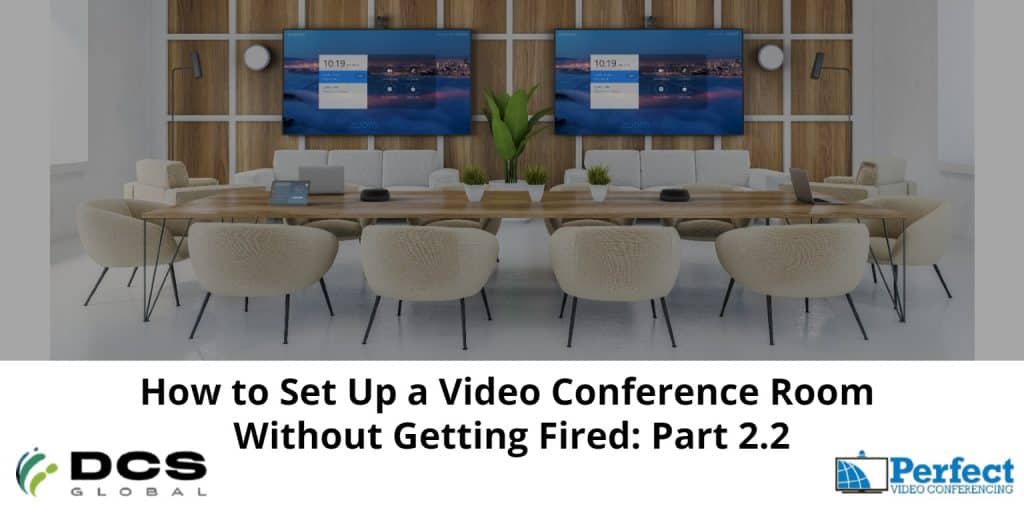

Written By: Randy Marcotte
In today’s digital age, the realm of communication is constantly evolving. With the rise of video conferencing and collaboration tools, IT managers find themselves at the helm, navigating the intricate waters of technology implementation. But amidst the allure of high-tech features and the maze of technical jargon, there lies a fundamental element that often goes unnoticed: the end-user community.
Randy Marcotte, President of DCS Global, emphasizes that the true measure of a successful video conferencing strategy is its adoption rate among end-users. If the system is perceived as complex, non-intuitive, or unreliable, even the most state-of-the-art setup can become redundant. The challenge for IT managers is to strike a balance – ensuring that the tools are technically sound while also resonating with the users’ needs and preferences.
In this comprehensive guide, we delve into the essential do’s and don’ts when crafting a video conferencing and collaboration strategy. From engaging with the end-user community to ensuring cross-platform compatibility, and from avoiding generic solutions to prioritizing security, we cover it all.
But beyond the technicalities, the essence of digital collaboration lies in human connection. It’s not just about devices talking to each other; it’s about people connecting, understanding, and collaborating. And when this connection is fostered with care and understanding, the results are transformative.
Join us as we explore the nuances of designing collaboration solutions that not only function seamlessly but also enhance the overall user experience. Whether you’re an IT manager, a decision-maker, or an end-user, this guide offers valuable insights to elevate your video conferencing ecosystem.
Build a Conferencing Space and Don’t Get Fired? Focus on the End-User Community
Welcome to this week’s post. It’s a bit longer as we wanted to take a deeper dive into some of the pitfalls- the “do’s and don’ts” that we have seen. And yes, I’ve seen some IT staff lose their jobs due to failures to execute a collaboration strategy that meets the strategic needs of a customer.
In the rapidly evolving landscape of digital communication, IT managers are often at the forefront of implementing and managing video conferencing and collaboration tools. However, amidst the technical jargon and the allure of cutting-edge technology, there’s a critical component that often gets overlooked: the end-user community.
The success of any video conferencing and collaboration strategy hinges on its adoption by the end-users. If they find the system cumbersome, unintuitive, or unreliable, even the most advanced setup can fall flat. As IT managers, it’s our responsibility to ensure that the tools we implement not only meet technical standards but also cater to the needs and preferences of the users.
Here are five things IT managers should DO and five things they should AVOID when building out a video conferencing and collaboration strategy:
DOs:
DON’Ts:
While the technical aspects of a video conferencing and collaboration strategy are undeniably important, the human element is paramount. By focusing on the end-user community and ensuring that their needs are at the heart of the strategy, IT managers can build systems that are not only technically sound but also widely adopted and appreciated.
Remember, in the world of digital collaboration, it’s not just about connecting devices; it’s about connecting people. And when people feel valued and heard, the results can be truly transformative.
Next, our team and I wanted to help you design a strategy based on some important lessons we’ve learned. We have seen two categories of issues- those impacting the mobile home user and those impacting the conference room. Both of these user “groups” are also dramatically changing as we review the hybrid workweek with Video Conferencing as a core technology for all users.
The purpose of this additional content is to provide some guidance in both of these areas and help you support great audio and an immersive, collaborative, and dynamic experience in your video conferencing ecosystem.
End User Considerations:
First, let’s address the end users. Here are 10 basic do’s and don’ts that help standardize and elevate the overall meeting and video conferencing experience, especially audio quality.
It’s important to remember that video conferences are essentially replacing or complimenting in-person interactions that allow businesses to communicate more effectively. Like it or not, video conferencing is a core component of all company internal and customer interactions and is here to stay.
At DCS Global, as noted above, we have found that reminding the end user that just because they CAN do a mobile video call from an airport, on speakerphone, while walking, without a headset- doesn’t mean that they SHOULD. Maybe you don’t get fired—but perhaps they create a sub-par experience for colleagues.
Conference Room Considerations:
Next – the expensive conference rooms. We want to make sure you get the value you promised the business. It is important to point out some of the key issues we face when looking at video conferencing audio issues in your conference room. For the purpose of this section, I will focus generally on rooms that may or may not need a sound engineer and equipment that accomplishes some digital sound processing. A video call with bad audio will create much dissatisfaction with even the best video conferencing solutions and undermine the entire deployment. With this in mind, here are 10 key Dos and Don’ts to consider when looking at your conference rooms and the equipment choices you make.
In conclusion, building a successful video conferencing and collaboration strategy requires a balanced approach. By understanding the specific needs of your organization and being aware of common pitfalls, you can craft a strategy that not only enhances communication but also drives organizational growth.
Remember, in the realm of digital communication, it’s not just about having the tools but using them effectively. With the right strategy in place, you’re not just setting up a conferencing space; you’re paving the way for innovation, collaboration, and success.
Please follow our blog series. In this series, we are glad to provide you with the essential tools you need to build an HD Video Conferencing Room that is PERFECT and not get fired in the process.
About DCS Global & Perfect Video Conferencing
DCS Global is a collaboration, consulting, services, and audiovisual (AV) integration company that provides various services related to digital signage, wayfinding, and kiosk manufacturing and deployment. The company specializes in creating interactive and engaging experiences for customers, visitors, and employees.
Their services include:
DCS Global offers a comprehensive range of services to help organizations enhance their communication, customer experience, and operational efficiency through innovative digital solutions.
About PVC
Perfect Video Conferencing (#perfectvc) is an Audio Visual and collaboration services company that specializes in designing and deploying cutting-edge video conferencing and collaboration spaces. Recently, PVC merged with DCS Global, and together, they offer a comprehensive range of products and services that are guaranteed to deliver an immediate ROI for their customers.
With a strong focus on design and deployment, Perfect Video Conferencing is committed to delivering solutions that offer some of the lowest total cost of ownership (TCO) in the industry. Their team of experts works closely with customers to understand their unique requirements and design solutions that are tailored to their specific needs.
Perfect Video Conferencing’s solutions are designed to help organizations of all sizes and industries enhance collaboration, improve productivity, and drive business success. Whether it’s a small meeting room or a large conference center, they have the expertise to design and deploy video conferencing and collaboration spaces that meet their customers’ needs.
In addition to their design and deployment services, Perfect Video Conferencing also offers a wide range of products, including video conferencing equipment, audiovisual solutions, and collaboration tools. Their team of experts provides ongoing support and maintenance to ensure that their solutions continue to deliver value over the long term.
Overall, Perfect Video Conferencing (#perfectvc) is a leading provider of audiovisual and collaboration services, delivering innovative solutions that help organizations improve communication, collaboration, and productivity. With their recent merger with DCS Global, they are now even better positioned to help their customers achieve their business goals.
About Randy N. Marcotte
Randy N. Marcotte is an accomplished business leader and President of DCS Global, a leading communications and collaboration company. With a proven track record of success in the industry, Randy has a strong background in organizational change, sales enablement, and customer satisfaction.
Before his role at DCS Global, Randy was the co-founder and CEO of Perfect Video Conferencing, which merged with DCS Global to provide a broader range of solutions to their clients. As the former owner and manager of Change Experts, Randy brings a wealth of experience in driving growth and success for businesses of all sizes.
Randy is passionate about building lasting relationships with his clients and partners and providing innovative solutions that deliver exceptional value. In his spare time, he enjoys traveling the world, skiing deep powder, and participating in marathons. Randy has completed 22 marathons around the world and will be completing his 23rd marathon in Nice, France this fall.
With a dedication to partnership, value, innovation, and excellence, Randy is proud to join the team at DCS Global and looks forward to continuing to bring new solutions to their loyal customer and partner base.
DCS Global is a collaboration, consulting, services, and audiovisual (AV) integration company that provides various services related to digital signage, wayfinding, and kiosk manufacturing and deployment. The company specializes in creating interactive and engaging experiences for customers, visitors, and employees.
services include:
DCS Global offers a comprehensive range of services to help organizations enhance their communication, customer experience, and operational efficiency through innovative digital solutions.
Perfect Video Conferencing (#perfectvc) is an Audio Visual and collaboration services company that specializes in designing and deploying cutting-edge video conferencing and collaboration spaces. Recently, PVC merged with DCS Global, and together, they offer a comprehensive range of products and services that are guaranteed to deliver an immediate ROI for their customers.
With a strong focus on design and deployment, Perfect Video Conferencing is committed to delivering solutions that offer some of the lowest total cost of ownership (TCO) in the industry. Their team of experts works closely with customers to understand their unique requirements and design solutions that are tailored to their specific needs.
Perfect Video Conferencing’s solutions are designed to help organizations of all sizes and industries enhance collaboration, improve productivity, and drive business success. Whether it’s a small meeting room or a large conference center, they have the expertise to design and deploy video conferencing and collaboration spaces that meet their customers’ needs.
In addition to their design and deployment services, Perfect Video Conferencing also offers a wide range of products, including video conferencing equipment, audiovisual solutions, and collaboration tools. Their team of experts provides ongoing support and maintenance to ensure that their solutions continue to deliver value over the long term.
Overall, Perfect Video Conferencing (#perfectvc) is a leading provider of audiovisual and collaboration services, delivering innovative solutions that help organizations improve communication, collaboration, and productivity. With their recent merger with DCS Global, they are now even better positioned to help their customers achieve their business goals.



Email: info@dcs.global
Phone: 877.201.7914
2435 N. Central Expressway
Suite 1200
Richardson, TX 75080
United States
15300 Redmond-Woodinville Rd
Suite C1/04
Woodinville, WA 98072
United States
22722 29th Drive SE
Suite 100
Bothell, WA 98021
United States
4065 Watts St,
2nd Floor
Emeryville, CA 94608
United States
38016 Cleveland Avenue
p1159
Squamish, BC V8B 0A8
Canada